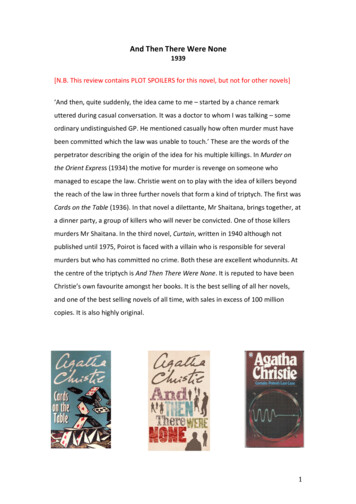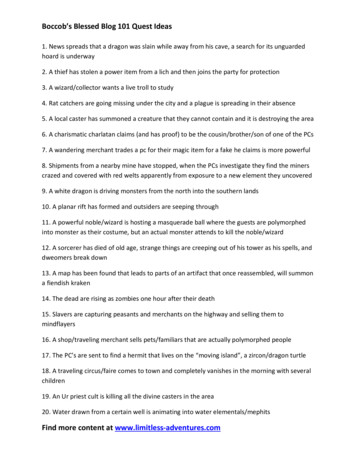
Transcription
And Then There Were None1939[N.B. This review contains PLOT SPOILERS for this novel, but not for other novels]‘And then, quite suddenly, the idea came to me – started by a chance remarkuttered during casual conversation. It was a doctor to whom I was talking – someordinary undistinguished GP. He mentioned casually how often murder must havebeen committed which the law was unable to touch.’ These are the words of theperpetrator describing the origin of the idea for his multiple killings. In Murder onthe Orient Express (1934) the motive for murder is revenge on someone whomanaged to escape the law. Christie went on to play with the idea of killers beyondthe reach of the law in three further novels that form a kind of triptych. The first wasCards on the Table (1936). In that novel a dilettante, Mr Shaitana, brings together, ata dinner party, a group of killers who will never be convicted. One of those killersmurders Mr Shaitana. In the third novel, Curtain, written in 1940 although notpublished until 1975, Poirot is faced with a villain who is responsible for severalmurders but who has committed no crime. Both these are excellent whodunnits. Atthe centre of the triptych is And Then There Were None. It is reputed to have beenChristie’s own favourite amongst her books. It is the best selling of all her novels,and one of the best selling novels of all time, with sales in excess of 100 millioncopies. It is also highly original.1
The problem that Christie set herself was how to construct a novel in which all thecentral characters die. She wrote in her Autobiography: ‘I had written this bookbecause it was so difficult to do that the idea fascinated me. Ten people had to diewithout it becoming ridiculous or the murderer being obvious. I wrote the book aftera tremendous amount of planning It was well received and reviewed, but theperson who was really pleased with it was myself, for I knew better than any critichow difficult it had been.’The plot outline is simple: ten people aremurdered because each was a killer whohad evaded the law. But there remaineda difficult narrative problem – how totell the tale so that it is plausible,mysterious and entertaining. Christiehad not faced such a tricky narrativeproblem since The Murder of Roger Ackroyd. She found the solution in a nurseryrhyme: Ten Little Soldier Boys, as it is now known. In the rhyme the ten soldier boysdie in turn and each by a different method. The rhyme ends: ‘One little soldier boyleft all alone; He went and hanged himself . And then there were none.’ With theseingredients Christie’s imagination constructs the bones of the story. Ten killers arebrought to an uninhabited island and murdered one by one, each murder related tothe mode of death of the relevant soldier boy of the rhyme, and the dramaheightened when, after each murder, a china figure soldier is smashed. The nurseryrhyme gives the needed structure, and also adds an eerie malevolence, like an evilclown or a blinded teddy bear.Christie must have liked the dramatic effect of the juxtaposition of murder withnursery rhymes for she went on to use such rhymes in the titles of a further fivebooks even though in these subsequent books the rhymes were not needed to solveany narrative problems.2
In Cards on the Table, Mr Shaitana decides for one evening to collect murderersrather as he collects exotic objects: ‘A murderer can be an artist’ he says, and goeson: ‘the caught murderer is necessarily one of the failures’. The perpetrator in AndThen There Were None takes a similar attitude. ‘I have wanted to commit a murdermyself. I recognized this as the desire of the artist to express himself! I was, or couldbe, an artist in crime!’ But whereas Mr Shaitana is foolish, and ends up the victim,the perpetrator in And Then There Were None is completely in control. Like Shaitanahe admires the criminal who defeats the police. ‘It was my ambition’ he writes, ‘toinvent a murder mystery that no one could solve’, but he wants others to know howclever he has been and so writes an account of his murders to be found after hisdeath.In writing And Then There Were None Christie is like her perpetrator: she wants toinvent a murder mystery ‘that no one could solve’? Her aim, I think, was not toconstruct a genuine whodunnit – a puzzle that is difficult but which can be solved –but instead to write a crime novel that leaves the reader baffled and intrigued –more like a locked-room mystery than a whodunnit? Unlike in the majority of hercrime novels there is little attempt to give the reader genuine clues. In thedenouement three clues are mentioned, but they are so arcane, and one purelysymbolic, that they can hardly be considered proper clues at all. But how aboutthrough the novel itself? After the third murder, there is what one might call aPoirot-like moment. Justice Lawrence Wargrave, a retired high court judge, takescharge. The murderer, he tells his six fellow ‘guests’, must be one of us. ‘We allqualify’. He goes on: ‘My point is that there can be no exception allowed on thescore of character, position, or probability. What we must now examine is thepossibility of eliminating one or more persons on the facts’. We are again remindedof Poirot twenty or so pages later when Wargrave replies to Armstrong’s question asto whether he knows who the murderer is: ‘But it appears to me, reviewing thewhole business, that one particular person is sufficiently clearly indicated. Yes, Ithink so.’ Irritatingly, just like Poirot, he does not enlarge on this.3
However carefully we read we do not seem to know enough of people’s movementsat the time of each crime to be able to eliminate anyone as a suspect. There is simplyinsufficient detail. The doctor, Armstrong, has the best opportunity for the secondmurder since he gave the victim medication and she is found dead in bed the nextmorning: ‘One overslept himself and then there were eight’. He also has the bestopportunity for killing General MacArthur. Neither of these is conclusive, and, itturns out, neither is relevant. There is one potential structural problem with a plot inwhich ten people are killed, one by one: won’t the murderer simply be the last onestanding? The story takes us to the final survivor, Vera Claythorpe, committingsuicide. She stands on a chair, puts her head in the noose, and kicks the chair away.And yet, we learn in the epilogue, the police findthe chair neatly pushed against the wall of theroom. Someone must have still been alive and onthe island after Vera died. Christie solves thepotential problem by devising a rather clever wayfor the murderer’s death to be faked. Wargravepersuades Dr Armstrong to declare to the othersthat he is dead after a faked shooting arguing thatthis will allow him to move about the house and spy, enabling him to identify themurderer. Armstrong falls for this ruse, the trusting camaraderie of professionalmen, and is the next victim.We argued that in Cards on the Table Christie was exploring the possibility of usingpsychological clues to solve a whodunnit rather than the kind of objective factualclues that Wargrave suggested should be relied upon. We claimed that Christie’sexperiments with psychological clues were noble failures. In And Then There WereNone Christie is not much concerned with clues and yet, paradoxically, the readermight solve the question of who is the murderer using only psychological clues. Notsolve with any degree of confidence – psychological clues still seem inadequate in awhodunnit – but tentatively propose what is, in fact, the correct solution. The wholeset-up is that of a judge passing sentence (and carrying out the punishment). At the4
end of the gramophone record that is played to the victims when they first arrive onthe island the mystery voice says: “Prisoners at the bar, have you anything to say inyour defence?’ After the third murder Wargrave confidently tells the others thatwhat is happening is ‘neither more nor less than the execution of justice uponcertain individuals for offences which the law cannot touch.’ There are a few furtherhints. Wargrave is the only person whose letter inviting him to the island was notfrom ‘U. N. Owen’. When Vera Claythorne tells her companions that Emily Brentconfided in her – telling her the circumstances of the death for which she may havebeen responsible – Wargrave asks whether Brent appeared troubled ‘by a sense ofguilt or a feeling of remorse’. This is a question that is likely to be of interest only tothe murderer. Wargrave seems to know that there is no place on the island wheresomeone can hide. Since he has not searched the island and says that he ‘isunacquainted with this part of the world’ how can he possibly know, unless he lied?None of these clues is at all conclusive.The drama of the novel is brilliantly conceived. The slow attrition – one more victim,one more suspect off the list. The realisation that one of them is the murderer. Thelinking of the murders to the verses of the nursery rhyme together with the breakingof a china soldier after each death has dramatic brilliance and macabre humour.There are some weaknesses of plot. Perhaps the most significant is that despite thefact that several people carry the supposed corpse of Wargrave up the stairs andinto his bedroom, none, apart from the doctor, realises that he is alive. How he wasable to suppress his breathing during this time, or suppress any cry as he was hauledup the stairs, is almost beyond belief. And his body was seen again many hours laterwhen the house was being searched and again no one noticed that he was stillwarm, pink and breathing. Wargrave was very lucky in several other ways. Had theweather remained as it was on the first day, one of the others – Lombard forexample – would have swum the mile to shore and got help. Indeed there is amoment before the storm when Lombard or Blore might well have decided to swimfor help to the mainland. Several of the deaths, as they occur, seem almost magical –how could they have been carried out without anyone else seeing? And inWargrave’s account of his crimes he seems to do a lot of “slipping in” to places and5
carrying out the murders with almost unbelievable deftness especially for aterminally ill old man. The absence of any sound heard when Wargrave wasapparently shot deserved more thought than it was given and those left alive failedto consider who could have had the opportunity to shoot him. The murder of Blorewould have been difficult to execute. How could Wargrave have ensured that Blorewould walk under that specific window and at a time when Wargrave was ready forhim, and that the marble clock would hit him so squarely on the head? Finally, VeraClaythorpe’s suicide is psychologically unconvincing. But all this is to carp at what is abrilliant and original crime novel.In many of the Poirot novels there is some discussion of the rights and wrongs ofmurder. Is murder ever justified? Does justice require murderers to be caught andtried and if guilty to be sentenced to death? Generally Poirot is firmly againstmurder, and believes murderers should face the full force of the law. In Appointmentwith Death he suggests that the character of the victim is irrelevant to the moralityof murder, and yet in Murder on the Orient Express and in Curtain he seems to thinkthat murder may sometimes be justified. In And Then There Were None there is noPoirot to comment on the morality of Wargrave’s crimes. In a country in which thedeath penalty is the mandatory sentence for murder, is it morally permissable for anindividual to kill people who have themselves killed but who will escape the law?In keeping with the justice system in Britain at the time, Wargrave believes thatmurderers should be killed. He considers that all his victims are murderers, from amoral point of view, even though most have not, from a legal point of view,committed murder. In order for a person to be guilty of murder two criteria normallyneed to be met. First the person must have acted in such a way as to have causedthe victim’s death – that is, he must have killed the victim. This is called the actusreus. In most situations, failing to save a person’s life is not sufficient for murder(unless there was a legal duty to save). Second the person must have intended to kill(or cause serious injury) – the so called mens rea. Wargrave’s victims were all, tosome extent, responsible for the deaths of others, but that is a long way from sayingthat that they were murderers, either legally or morally. Christie has given us an6
interesting variety of ways in which a person can be responsible for a death. Five ofWargrave’s victims did not intend the deaths: Dr Armstrong whose incompetentsurgery while drunk caused his patient’s death; Miss Brent, whose dismissal of amaid is a factor leading to the maid’s suicide; Mr Lombard who abandons the menhe is leading and takes their food in order to save his own life; Mr Marston whoaccidentally kills two children whilst driving dangerously; and Mr Morris, who sellsillegal drugs leading to the suicide of at least one of the addicts. The other fivevictims intended, or hoped for, the deaths. Blore by giving false evidence;Claythorne, and Thomas and Ethel Rogers, by failing to save a life; and GeneralMacArthur by deliberately sending a subordinate on a dangerous military mission. Inmodern law some of Wargrave’s victims have committed serious crimes, althoughnot murder. Armstrong might be guilty of criminal negligence or manslaughter – afew doctors had been so charged prior to 1939. Mr Morris is selling illegal drugs.Blore is a bent copper (crooked policeman). General MacArthur may havecommitted a crime under military law. Marston’s dangerous driving might well havebeen a crime under the Motor Car Act of 1903, and the 1930 Road Traffic Act.The point is that Wargrave is not fitting his punishments to the crimes. The deathpenalty, even in 1939, was not the punishment for the crimes that most of hisvictims had committed. If one lays the law to one side and focuses on moralresponsibility again Wargrave’s thinking appears sloppy. Emily Brent may be selfrighteous and rigid, but dismissing a maid is a long way, morally, from murder. Brentneither intended, nor even hoped for, her maid’s death, nor was her act a directcause of that death. Even the most severe judge can hardly support the deathpenalty as the appropriate punishment for her morally bad behaviour. There is awide range in moral culpability of Wargrave’s victims – a range that Wargraveignores. Wargrave’s sloppy thinking is also apparent in his disregard for the quality ofevidence. He claims that he is justly punishing those who will evade the law. But inmany cases his evidence about what his victims have done is hearsay, based on oneperson’s report during a casual conversation. It is not clear from the evidenceavailable to Wargrave that all of his victims are responsible for the deaths at all – noteven ‘on the balance of probabilities’ let alone ‘beyond reasonable doubt’. One can7
only conclude that what drives Wargrave’s murders is that he wishes to commit aseries of baffling murders in a dramatically brilliant way. The idea that he is anavenging angel dealing out justice is a fig-leaf to cover his base motives.Wargrave, although apparently believing that all his victims deserve death writesthat he killed Marston and Mrs Rogers first because their guilt was the lightest. Inthe case of Marston this was not because the deaths were unintended: the samewas true of four of Wargrave’s other victims. It was because he was “a type bornwithout that feeling of moral responsibility which most of us have”. His very lack ofremorse for what he had done lessens his guilt, in Wargrave’s view. Mrs Rogers’ guiltis lessened, according to Wargrave, because she had “no doubt” acted largely underthe influence of her husband.Wargrave may have begun to plan his murders from a misplaced sense of justice –stepping in where the law cannot reach – but he carried on, and was carried away bythe desire to be “an artist in crime”. In her construction and execution of And ThenThere Were None Christie shows, perhaps more than in any other novel, just what anartist she was in crime fiction.Burgh Island8
IllustrationsFrom the 1945 film: yet another of the soldier boys (North American ‘Indians’ in thiscase) has been smashed. herewere-ten-little-indians/]Vera contemplates suicide. From the 1945 gh Island, on Devon’s South coast between Plymouth and Torbay – theinspiration for Soldier Island. In fact only a couple of hundred yards from themainland.[TH]9
And Then There Were None 1939 [N.B. This review contains PLOT SPOILERS for this novel, but not for other novels] ‘And then, quite suddenly, the idea came to me – started by a chance remark uttered during casual conversation. It was a doctor










